|
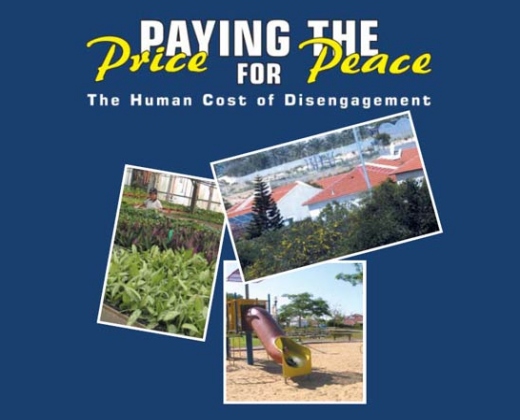
Paying the Price for Peace:
The Human Cost of Disengagement
28 Jul 2005,
PDF version (1240 KB)
Deutsche Version
|
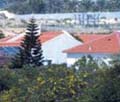
Neve Dekalim
(Avi Ohayon/GPO) |
 Israel backs its words with action and is willing to pay a major
price for peace.
Israel backs its words with action and is willing to pay a major
price for peace.

Umschlagfotos (s.o.):
Links: Ein Treibhaus in Bnei Atzmon (Sasson Tiram)
Oben re.: Neve Dekalim (Avi Ohayon/GPO)
Unten re.: Spielplatz in Morag (Sasson Tiram) |
 Introduction Introduction
Establishing peace is a fundamental goal of Jewish
tradition and the declared policy of the State of Israel. Israel has
long sought peace with its Arab neighbors and particularly with the
Palestinians. The great challenge in making peace is that it is a
process that hopefully does not end just with the cessation of
hostilities between former enemies, but with the beginning of a new
relationship of coexistence. Israel’s ultimate goal is to establish good
neighborly relations with a Palestinian state.
Against the background of more than four years of
terrorist bloodshed, Israel has initiated its Disengagement Plan in the
Gaza Strip and northern Samaria, both to enhance its security and to put
the peace process with the Palestinians back in motion. For it to have a
chance to work, the plan requires a considerable sacrifice on the part
of some 1,700 settlers and their families, or about 8,000 people who
must leave the homes and livelihoods they have built over the course of
several decades.
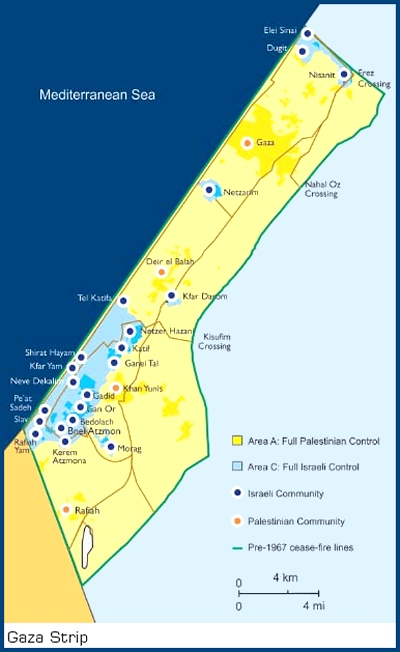
Koret Communications Ltd.
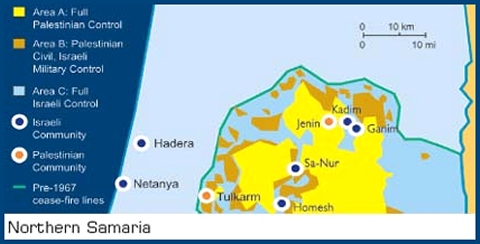
Koret Communications Ltd.
In the short term, it is these settlers who are paying
the greatest part of the price for peace. It is they who were encouraged
by previous governments to settle barren land and turn it into homes,
gardens, and farms, in the same pioneering spirit that built the State
of Israel. They are now being asked to relinquish these accomplishments
for the greater good.
Many of these pioneers came to the Gaza Strip, for
example, as young couples - and are now facing the trauma of leaving
their homes with their children and grandchildren, for whom Gaza has
been their only home.
The following capsule descriptions of the 25 settlements included in the
Disengagement Plan show what some of Israel’s pioneers are giving up for
peace.
A home in Gadid,
Moshe Milner / GPO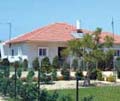
The Gaza Strip
Gush Katif
Bedolah
A moshav (freeholders’ collective) founded in
1986 as part of the Hapoel Hamizrahi religious moshav movement
and the Bnei Akiva national religious youth movement, Bedolah
has 33 families and a population of about 220. Most of its
members grow peppers, tomatoes, and other vegetables in
hothouses for the local market and for export. In recent years a
number of immigrants from France joined the moshav, adding to
its cultural diversity.
Bnei Atzmon
Founded in 1978 following the Camp David
Accords, Bnei Atzmon is a mixed collective/privatized religious
moshav of some 70 families comprising more than 500 people. The
settlement has a well-developed educational system for some 550
pupils from nursery school through high school. Bnei Atzmon has
more than 5,000 dunams (1,250 acres) of field crops, 12 dunams
(3 acres) of turkey runs, a dairy, a construction firm, and a
plant nursery considered to be one of the most advanced in the
region.
Gadid
Established in 1982 by a group of 22 Bnei
Akiva (national religious youth movement) families, Gadid now
has some 60 families, with another 15 families from France
staying at its immigrant absorption center. Unlike the other
agricultural settlements in the Gaza Strip, Gadid’s original
hothouses were built alongside the residences. As the settlement
grew, additional hothouses were added beyond the residential
area, including ones operated by the Berbie family to produce
medicinal herbs. About 60 percent of the herbs exported by
Israel come from Gush Katif.
Gan Or
A member of the Hapoel Hamizrahi religious
moshav movement, Gan Or was founded in 1983 by graduates of the
Bnei Akiva and hesder yeshiva movements, the latter which
combines yeshiva study and military service. Most of its 50
families earn their livelihoods from vegetable hothouses, with
the rest belonging to the free professions. The community, which
recently completed building a synagogue and adjacent events
hall, also houses the Tohar Girls College, which offers
religious studies and extension courses at the Open University
and at Bar-Ilan University’s campus at nearby Ashkelon.
 A
flower hothouse in Ganei Tal,
Avi Ohayon / GPO A
flower hothouse in Ganei Tal,
Avi Ohayon / GPOGanei Tal
This religious moshav was founded in 1979 by Bnei
Akiva graduates. Most of its 65 families make their living from
hothouses where they grow agricultural produce, including organic
vegetables, flowers, seeds, house and garden plants, and spices.
Ganei Tal also prides itself on its wide range of cultural
activities.
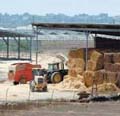 A farm shed in Katif,
Moshe Milner / GPO A farm shed in Katif,
Moshe Milner / GPOKatif
Ten veterans of the Bnei Akiva movement and
the IDF established Katif in 1985 after undergoing
agricultural training at nearby Moshav Bnei Darom. Today the
moshav numbers more than 60 families and has a population of
about 330, some 220 of them children. In addition to its many
other educational institutions, its members founded the Katif
Yeshiva for Marine and Desert Environmental Studies, which
combines religious and environmental study. Katif operates a
dairy and manufactures fabrics and hothouse equipment, while its
own hothouses produce vegetables for export.
 A playground in Katif, Sasson Tiram A playground in Katif, Sasson Tiram
Kerem Atzmona
Established in 2001 by five families in an
abandoned orchard between the settlements of Bnei Atzmon and
Morag, Kerem Atzmona today numbers some 15 families with a
population of about 60. It members work in education and the
professions.
Kfar Yam
This tiny settlement on the shore west of Neve
Dekalim was established by two families in a derelict Egyptian
Army resort in 1983. Its population increased by a third family
in 1985 and a fourth in 1996. It is classified as a “settlement
of individuals.”
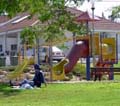 A house in Morag,
Sassom Tiram A house in Morag,
Sassom Tiram
Morag
The southernmost of the Gush Katif settlements,
Morag began as a Nahal outpost in 1972 and became a religious
moshav in 1983, affiliated with the Hapoel Hamizrahi movement.
Most of its 29 families work in agriculture, growing tomatoes,
leafy vegetables, spices, and other produce in hothouses.
Despite coming under constant terrorist attacks, Morag recently
added seven more families and completed building a central
structure for use as a synagogue.
 Taking care of horses at Pe’at
Sadeh,
Moshe Milner / GPO Taking care of horses at Pe’at
Sadeh,
Moshe Milner / GPO
Netzer Hazani
Originally established as a Nahal settlement
in 1973, Netzer Hazani was founded as a civilian moshav by 12
religious families in 1997. Today most of its 70 families make
their living from hothouse agriculture, growing organic
vegetables and a wide variety of spices for export, as well as
breeding fish in fishponds.
Neve Dekalim
This religious communal settlement of some 500
families (population about 2,600) is the largest in the Gaza
Strip and serves the other settlements as an administrative and
service hub. Neve Dekalim maintains the offices of the local
council, religious and health services, a commercial and
industrial center, a wide variety of religious educational
institutions and youth movements, cultural activities, a
community center, and the regional library.
Pe’at Sadeh
Established as a temporary settlement in 1989,
Pe’at Sadeh moved to its present location on a hill overlooking
the sea in 1993. Its 20 families comprise 110 inhabitants, 70 of
whom are children. The residents of this communal settlement are
a mixture of secular, traditional, and religious. Most engage in
agriculture, with the remainder in the professions.
 A home in Rafiah Yam,
Moshe Milner / GPO A home in Rafiah Yam,
Moshe Milner / GPORafiah Yam
This mixed secular/religious communal
settlement was established at a temporary site in 1984 by young
couples from various parts of Israel and moved to its present
location in 1991. Most of its 25 families (population about 100)
make their living from advanced hothouse agriculture, while
community seamstresses manufacture clothing for Israel’s leading
fashion houses.
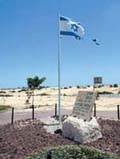 A memorial to a victim of
Palestinian terrorism in Rafiah Yam,
Moshe Milner / GPO A memorial to a victim of
Palestinian terrorism in Rafiah Yam,
Moshe Milner / GPO
Shirat Hayam
Founded in 2000 in response to the terrorist
bombing of a schoolbus at nearby Kfar Darom, the settlement on
the seashore has 16 families with 26 children. Most residents
work in agriculture, with the remainder in the professions.
Slav
First established in 1980 as a Nahal
settlement, Slav began functioning after the Sinai withdrawal in
1982 as a staging camp for settler groups and as the site of the
Midreshet Hadarom college. Today three families live in one part
of the settlement, while the rest serves as a Border Police base.
Tel Katifa
Founded a few months before the signing of the
Oslo Accords in 1992, the settlement has 15 families, most of
whom make their living from agriculture with a view to
developing the seaside location - which boasts a natural lake -
for tourism.
|
Synagogues of Gush Katif
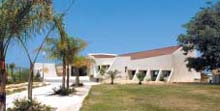
Katif |
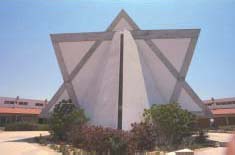
Neve Dekalim,
Nathan Alpert / GPO
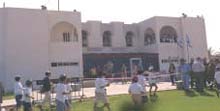
Bnei Atzmon
Amos Ben Gershom / GPO |
The North and Central Gaza Strip
Dugit
Founded in 1990, Dugit is a seaside communal
settlement of about 20 families (70 people) who make their
living from fishponds and tourism. After living in caravans
since Dugit’s establishment, several families received
permission to build permanent homes.
Elei Sinai
Founded in 1983, in part by settlers forced to
leave Sinai under the peace treaty with Egypt, Elei Sinai is a
secular communal settlement of some 85 families with a
population of about 350. Most of its members are professionals
who work in nearby Ashkelon, some 15 kilometers away.
 A neighborhood in Nisanit A neighborhood in Nisanit
Amos Ben Gershom / GPO
Nisanit
The largest settlement in the northern Gaza
Strip, Nisanit has some 300 families and a population of about
1,300. Founded originally as a Nahal settlement in 1980, it
became a civilian communal settlement in 1993. A secular
community, its mostly professional residents work in nearby
settlements or in the city of Ashkelon.
 Working at a produce plant in
Kfar Darom Working at a produce plant in
Kfar Darom
Sasson Tiram
Kfar Darom
This historic religious moshav had its origins
more than 70 years ago, when a man named Tuvia Miller purchased
some 260 dunams (65 acres) there for a fruit orchard. His
holding was destroyed during the Arab riots of 1936-39, but the
Jewish National Fund bought Miller’s land in 1946, when it was
settled by a group of religious kibbutzniks. During Israel’s War
of Independence, Kibbutz Kfar Darom held out
against the invading Egyptian Army for nearly three months,
until the IDF ordered its defenders to abandon it in the summer
of 1948.
Following the Six Day War, Kfar Darom was
reestablished as a combined military/agricultural settlement by
the IDF’s Nahal Corps and reverted to civilian status as a
religious settlement in 1989. Today Kfar Darom has some 65
families and a total population of about 400. Its Institute for
Torah and Land seeks solutions for special problems posed by
modern agriculture and religious law, and its members earn their
livelihoods from agriculture, education, and the professions.
Its industrial section houses a regional packinghouse and among
its educational facilities is a Center for Child Development.
Netzarim
Founded as a Nahal settlement in 1972 by a
group from the secular Hashomer Hatzair movement, Netzarim
became a civilian religious settlement in 1984. Several years
later its members decided to dissolve the kibbutz and change
Netzarim into a communal settlement. Its 60 families (population
400) operate a welldeveloped economy that includes hothouse
agriculture (tomatoes for export, mangos, leafy vegetables), a
chicken run, and a quarry. Some of its members work on
neighboring settlements.
Due to the security situation, Netzarim’s children study at Bnei
Atzmon. However, three years ago a hesder yeshiva was
established in the settlement with 20 soldier/students.
Northern Samaria
Ganim
This secular communal settlement was established in
1983 and has 30 families. Planned for an eventual population of some 300
families, Ganim was intended to be part of a string of communities
across northern Samaria.
Homesh
A mixed secular/religious residential community,
Homesh began in 1978 as a Nahal settlement and became civilian with 30
families in 1988. Its location on the highest hilltop in the area
affords it a panoramic view of its surroundings and was a security
factor in its planning.
Kadim
This secular residential community was first
established as a Nahal outpost in 1983, then became civilian the
following year with the arrival of 25 families. It was planned to
comprise 200 families.
Sa-Nur
Originally settled by the Dotan core group in 1977,
this religious communal settlement changed its name to Sa-Nur in 1987
after serving as an artists’ colony since 1984. It has 15 families and
was planned for 80.
Removing the Jewish communities from the Gaza Strip and northern Samaria
means:
¦ 42 day-care centers, 36 kindergartens,
seven elementary schools, and three high schools will be closed
¦ 5,000 schoolchildren will need to find new schools
¦ 38 synagogues will be dismantled
¦ 166 Israeli farmers will lose their livelihoods - plus some 5,000 of
their Palestinian workers
¦ 48 graves in the Gush Katif Cemetery, including those of six residents
murdered by terrorists, will be exhumed and moved to Israel.
Deutsche Version
hagalil.com /
01-08-2005
|